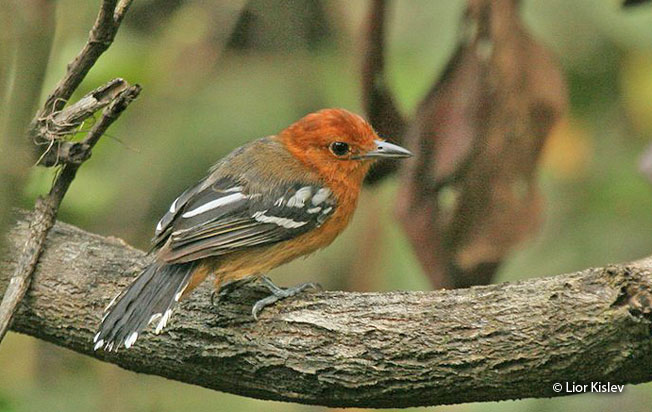Order: Passeriformes | Family: Thamnophilidae | IUCN Status: Least Concern

Age: Adult | Sex: Male | Loc. Tahuayo River, Loreto

Age: Adult | Sex: Female | Loc. Tahuayo River, Loreto

Age: Adult | Sex: Male | Loc. Iquitos area, Loreto

Age: Adult | Sex: Female | Loc. Tahuayo River, Loreto
Identification & Behavior: ~14 cm (5.5 in). The male Amazonian Antshrike is slaty-gray with a black crown. The wing coverts are black tipped with white dots forming wing bars. The tertials are also fringed with white. The tail feathers are tipped with white. The female is orange-rufous with the wing and tail similar to that of a male. It forages in the vegetation that overhangs on river and lake edges; mostly along blackwater rivers. The ornate female resembles a female Black-crested Antshrike.
Status: The Amazonian Antshrike is uncommon and widespread in Amazonia. It does not occur in the foothill of the Andes. The Amazonian Antshrike also occurs in in Co, Ec, Br, and Bo.
Name in Spanish: Batará Amazónico.
Sub-species: Amazonian Antshrike (Thamnophilus amazonicus amazonicus), P. L. Sclater, 1858.
Meaning of Name: Thamnophilus: Gr. Thamnos= bush and philos= lover. amazonicus: L. Amazonicus or Amazoninus Amazonian, of Amazonia.
Distribution Map
Voice

Voice
References:
-
-
- Species range based on: Schulenberg, T. S., D. F. Stotz, and L. Rico. 2006. Distribution maps of the birds of Peru, version 1.0. Environment, Culture & Conservation (ECCo). The Field Museum. http://fm2.fieldmuseum.org/uw_test/birdsofperu on 03/01/2017.
-